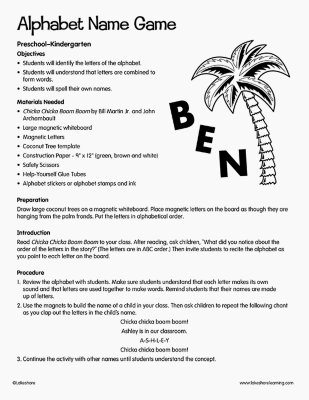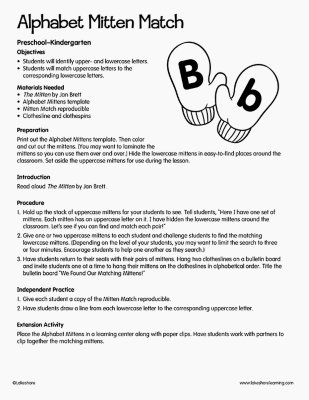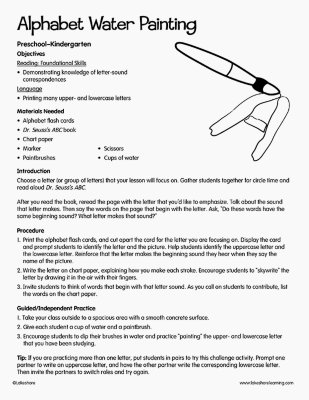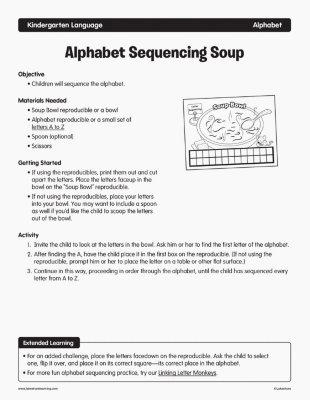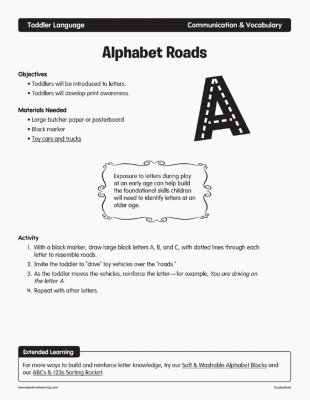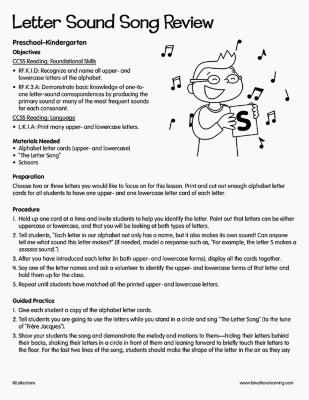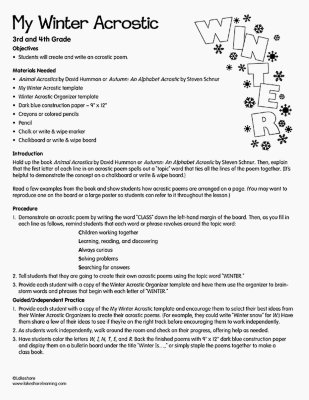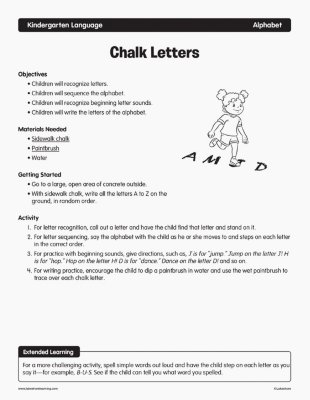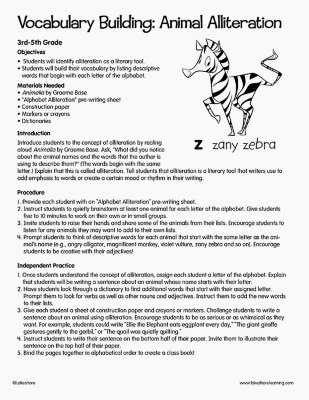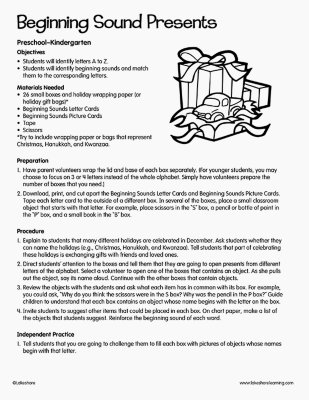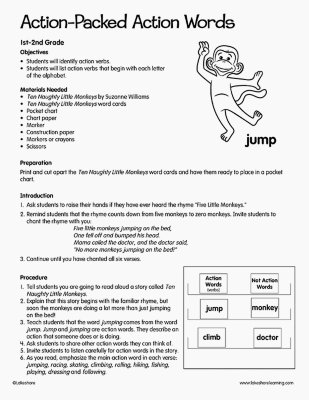Narrow by Grade
Grade
11 results for "alphabet"
Alphabet Name Game
Pre-K - Kindergarten
Objectives Students will identify the letters of the alphabet. Students will understand that letters are combined to form words. Students will spell their own names. Materials Needed Chicka Chicka Boom Boom by Bill Martin Jr. and John Archambault Large magnetic whiteboard Magnetic Letters Coconut Tree template Construction Paper - 9" x 12" (green, brown and white) Safety Scissors Help-Yourself Glue Tubes Alphabet stickers or alphabet stamps and ink Preparation: Draw large coconut trees on a magnetic whiteboard. Place magnetic letters on the board as though they are hanging from the palm fronds. Put the letters in alphabetical order. Introduction Read Chicka Chicka Boom Boom to your class. After reading, ask children, “What did you notice about the order of the letters in the story?” (The letters are in ABC order.) Then invite students to recite the alphabet as you point to each letter on the board.
View Lesson PlanAlphabet Mitten Match
Pre-K - Kindergarten
Objectives Students will identify upper - and lowercase letters. Students will match uppercase letters to the corresponding lowercase letters. Materials Needed The Mitten by Jan Brett Alphabet Mittens template Mitten Match reproducible Clothesline and clothespins Preparation. Print out the Alphabet Mittens template. Then color and cut out the mittens. (You may want to laminate the mittens so you can use them over and over.) Hide the lowercase mittens in easy–to–find places around the classroom. Set aside the uppercase mittens for use during the lesson.
View Lesson PlanAlphabet Water Painting
Pre-K - Kindergarten
Objectives Reading: Foundational Skills Demonstrating knowledge of letter-sound correspondences Language Printing many upper- and lowercase letters Materials Needed Alphabet flash cards Dr. Seuss’s ABC book Chart paper Marker Paintbrushes Cups of water Scissors Introduction Choose a letter (or group of letters) that your lesson will focus on. Gather students together for circle time and read aloud Dr. Seuss’s ABC. After you read the book, reread the page with the letter that you’d like to emphasize. Talk about the sound that letter makes. Then say the words on the page that begin with the letter. Ask, “Do these words have the same beginning sound? What letter makes that sound?”
View Lesson PlanAlphabet Roads
Toddler
Objectives
• Toddlers will be introduced to letters.
• Toddlers will develop print awareness.
Letter Sound Song Review
Pre-K - Kindergarten
Objectives CCSS Reading: Foundational Skills RF.K.1.D: Recognize and name all upper- and lowercase letters of the alphabet. RF.K.3.A: Demonstrate basic knowledge of one-to-one letter-sound correspondences by producing the primary sound or many of the most frequent sounds for each consonant. CCSS Reading: Language L.K.1.A: Print many upper- and lowercase letters. Materials Needed Alphabet letter cards (upper- and lowercase) “The Letter Song” Scissors
View Lesson PlanMy Winter Acrostic
3rd Grade - 5th Grade
Objectives Reading: Literature Reading and comprehending grade-appropriate literature, including stories, dramas, and poetry Writing Writing an acrostic poem Materials Needed Animal Acrostics by David Hummon or Autumn: An Alphabet Acrostic by Steven Schnur My Winter Acrostic template Winter Acrostic Organizer template Dark-blue construction paper - 9" x 12" Crayons or colored pencils Pencil Chalk or write & wipe marker Chalkboard or write & wipe board Introduction Hold up the book Animal Acrostics by David Hummon or Autumn: An Alphabet Acrostic by Steven Schnur. Then explain that the first letter of each line in an acrostic poem spells out a “topic” word that ties all the lines of the poem together. (It’s helpful to demonstrate the concept on a chalkboard or write & wipe board.) Read a few examples from the book and show students how acrostic poems are arranged on a page. (You may want to reproduce one on the board or a large poster so students can refer to it throughout the lesson.)
View Lesson PlanChalk Letters
Kindergarten
Objectives
- Children will recognize letters.
- Children will sequence the alphabet.
- Children will recognize beginning letter sounds.
- Children will write the letters of the alphabet.
Vocabulary Building: Animal Alliteration
3rd Grade - 4th Grade
Objectives Students will identify alliteration as a literary tool. Students will build their vocabulary by listing descriptive words that begin with each letter of the alphabet. Materials Needed Animalia by Graeme Base “Alphabet Alliteration” pre-writing sheet Construction paper Markers or crayons Dictionaries Introduction Introduce students to the concept of alliteration by realing aloud Animalia by Graeme Base. Ask, “What did you notice about the animal names and the words that the author is using to describe them?” (The words begin with the same letter.) Explain that this is called alliteration. Tell students that alliteration is a literary tool that writers use to add emphasis to words or create a certain mood or rhythm in their writing.
View Lesson PlanBeginning Sound Presents
Pre-K - Kindergarten
Objectives Students will identify letters A to Z. Students will identify beginning sounds and match them to the corresponding letters. Materials Needed 26 small boxes and holiday wrapping paper (or holiday gift bags)* Beginning Sounds Letter Cards Beginning Sounds Picture Cards Tape Scissors *Try to include wrapping paper or bags that represent Christmas, Hanukkah, and Kwanzaa. Preparation. Have parent volunteers wrap the lid and base of each box separately. (For younger students, you may choose to focus on 3 or 4 letters instead of the whole alphabet. Simply have volunteers prepare the number of boxes that you need.) Download, print, and cut apart the Beginning Sounds Letter Cards and Beginning Sounds Picture Cards. Tape each letter card to the outside of a different box. In several of the boxes, place a small classroom object that starts with that letter. For example, place scissors in the “S” box, a pencil or bottle of paint in the “P” box, and a small book in the “B” box.
View Lesson PlanAction-Packed Action Words
1st Grade
Objectives Students will identify action verbs. Students will list action verbs that begin with each letter of the alphabet. Materials Needed Ten Naughty Little Monkeys by Suzanne Williams Ten Naughty Little Monkeys Word Cards Pocket chart Chart paper Marker Construction paper Markers or crayons Scissors Preparation: Print and cut apart the Ten Naughty Little Monkeys word cards and have them ready to place in a pocket chart. Introduction Ask students to raise their hands if they have ever heard the rhyme “Five Little Monkeys.” Remind students that the rhyme counts down from five monkeys to zero monkeys. Invite students to chant the rhyme with you: Five little monkeys jumping on the bed, One fell off and bumped his head. Mama called the doctor, and the doctor said, “No more monkeys jumping on the bed!” Continue until you have chanted all six verses.
View Lesson Plan